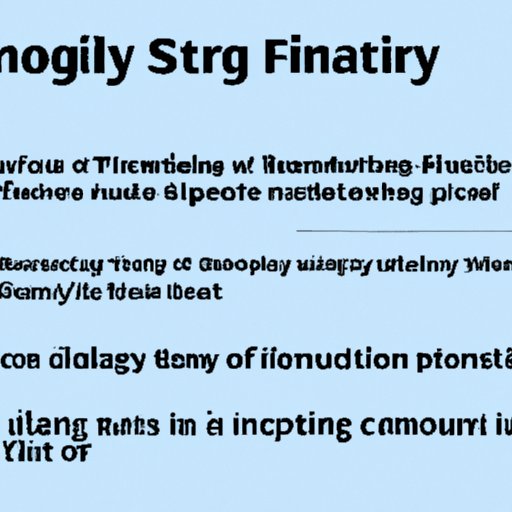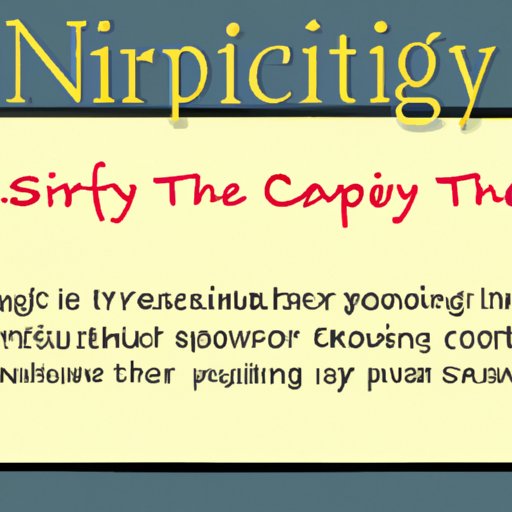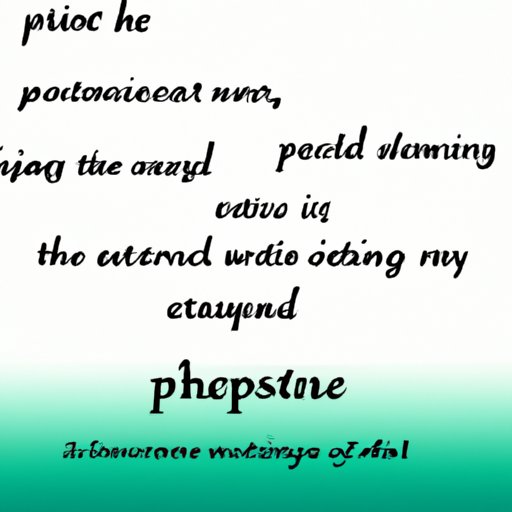Introduction
Imagery is a powerful tool used in literature to convey ideas and messages in a vivid and often poetic way. It is the use of descriptive language to paint a mental image for the reader, giving them an opportunity to experience the story from the author’s perspective. By understanding what imagery is and how it works, readers can gain insight into the deeper meanings of literature and appreciate the craftsmanship of authors.
Definition of Imagery in Literature
Imagery is the use of vivid or figurative language to represent objects, actions, and ideas in such a way that it appeals to our physical senses. Imagery can be either literal or figurative, and it can take many forms, including visual, auditory, olfactory, gustatory, tactile, kinesthetic, and organic. In literature, imagery is often used to create mood, set the tone, and evoke emotion in the reader.
Benefits of Using Imagery in Writing
Imagery adds depth and complexity to writing, allowing the author to create sensory experiences for the reader. It can help bring characters and settings to life, make descriptions more vivid, and add emotional resonance to stories. It can also be used to convey abstract concepts and provide insight into the motivations and feelings of characters.

Exploring the Power of Imagery in Literature
Imagery can be used to create vivid settings, evoke emotions, and enhance meaning in literature.
Creating Vivid Settings
Imagery can be used to create detailed and vivid settings that draw the reader into the world of the story. This can include descriptions of landscapes, buildings, furniture, clothing, and other objects. Authors can use imagery to make these settings seem real and alive, allowing the reader to visualize the story as if they were actually there.
Evoking Emotions
Imagery can be used to evoke strong emotions in the reader. By using sensory details and descriptive language, authors can create scenes that stir up feelings of joy, sorrow, fear, anger, and other powerful emotions. This can help bring characters and their situations to life, making the story more meaningful and impactful.
Enhancing Meaning
Imagery can also be used to add depth and meaning to a story. By using symbols, metaphors, and other figurative devices, authors can convey complex ideas and concepts in a subtle yet powerful way. This can help make stories more memorable and allow readers to explore different interpretations of the text.

How to Identify and Analyze Imagery in Fiction
Identifying and analyzing imagery in literature can help readers gain a better understanding of the text and appreciate the skill of the author. To do this, readers must be aware of the types of imagery being used and consider the context in which it is used.
Types of Imagery
Imagery can take many forms, including visual, auditory, olfactory, gustatory, tactile, kinesthetic, and organic. Here are some examples of each type of imagery:
- Visual Imagery: “The sky was a deep shade of blue, dotted with fluffy white clouds.”
- Auditory Imagery: “The birds chirped happily in the bright morning sun.”
- Olfactory Imagery: “The sweet scent of roses filled the air.”
- Gustatory Imagery: “The pie tasted like warm apples and cinnamon.”
- Tactile Imagery: “The soft grass tickled her feet as she walked.”
- Kinesthetic Imagery: “She felt the energy flowing through her body as she danced.”
- Organic Imagery: “Her heart beat faster as she walked into the room.”
Examining Context
Imagery can be used to convey different meanings depending on the context in which it is used. To understand the full impact of imagery in literature, readers must consider the setting, characters, and plot to gain insight into the author’s intentions.
Examining the Role of Imagery in Poetry
Imagery plays an important role in poetry, as poets often use vivid language and descriptive devices to create meaning and evoke emotion in the reader.
The Use of Metaphors and Similes
Metaphors and similes are often used to compare two unlike things and create a vivid image for the reader. For example, a poet might write, “Her voice was like a songbird in the morning.” This metaphor creates a vivid image and conveys the idea that the person’s voice is beautiful and melodic.
The Importance of Descriptive Language
Poets also use descriptive language to create sensory experiences for the reader. By using imagery to describe sights, sounds, smells, tastes, and textures, poets can evoke powerful emotions in the reader and make their poems more memorable.

Crafting Descriptive Imagery: Tips for Writers
Writing with vivid imagery can be a challenging but rewarding task. Here are some tips to help writers craft effective imagery:
Brainstorming Ideas
Before writing, it can be helpful to brainstorm ideas for imagery. This can include considering the five senses and thinking of ways to incorporate them into the story. It can also be useful to think about symbols that could be used to represent characters, settings, or themes.
Utilizing Sensory Details
Once ideas have been generated, writers should focus on incorporating sensory details that will help bring the imagery to life. This can include describing sights, sounds, smells, tastes, and textures that are relevant to the story.
Writing with Intention
Finally, writers should strive to write with intention. Imagery should be used intentionally to create a certain mood, set the tone, and evoke emotion in the reader. By writing with intention, writers can ensure that their imagery is effective and meaningful.
Conclusion
Imagery is a powerful tool used in literature to convey ideas and messages in a vivid and often poetic way. It can be used to create vivid settings, evoke emotions, and enhance meaning. By understanding what imagery is and how it works, readers can gain insight into the deeper meanings of literature and appreciate the craftsmanship of authors.
Summary of Main Points
This article explored the power of imagery in literature, discussing its ability to create vivid settings, evoke emotions, and enhance meaning. It also examined how to identify and analyze imagery in fiction and the role of imagery in poetry. Finally, tips for writers crafting descriptive imagery were provided.
Final Thoughts on the Power of Imagery in Literature
Imagery is a powerful tool that can be used to create vivid worlds and evoke strong emotions in readers. By understanding how to identify and analyze imagery, readers can gain insight into the deeper meanings of literature and appreciate the skill of authors. Writers, too, can benefit from understanding the power of imagery and using it intentionally to craft memorable stories.
(Note: Is this article not meeting your expectations? Do you have knowledge or insights to share? Unlock new opportunities and expand your reach by joining our authors team. Click Registration to join us and share your expertise with our readers.)
